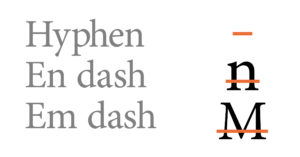Welcome to Type Tuesday.
The use of dashes and hyphens is often inconsistent in writing. These typography elements are easy to find on a keyboard, but did you know that they are actually three different horizontal marks of different lengths and uses?
They are called the hyphen, en dash and em dash.
In fact, each has a different role and function from the other and, when used correctly, provide that extra bit of punctuation and sharpness to your text.
Typography: What is a hyphen?
Hyphens link words or indicate a break in a word at the end of a line. It is the shortest of the three marks and is used to combine words. It is used to connect numbers, like for a phone number, but does not indicate a range of numbers; this is the job of an en dash.
Hyphen examples include:
- 444-654-896
- It’s all about the hands-on experience of setting metal type.
Typography: What is an en dash?
The en dash (approximately the width of a lowercase ‘n’) indicates a range of values or a connection between two things such as numbers, people or places. It is slightly longer than the hyphen but not as long as the em dash.
En dash examples include:
- 1200-1400
- The Edinburgh–London train is ready to depart.
Typography: What is an em dash?
The em dash (approximately the width of a capital ‘M’) marks an abrupt change of thought or a transition within a sentence. It is noticeably the longest of the three marks.
Em dash examples include:
- I wish you’d —oh, never mind.
- Ripe, juicy strawberries—such as the ‘Sparkle’ variety—are perfect for jam making.
According to ‘Type Matters’ by Jim Williams, they are also referred to as ‘nut dash’ and ‘mutton dash’ respectively.
For more detail, take a look at Punctuationmatters.com
